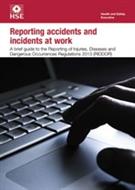Quick Search
Show me:
Reporting Accidents And Incidents At Work, INDG453
A Brief Guide to the Reporting of Injuries, Diseases and Dangerous Occurrences Regulations 2013 (RIDDOR), INDG453, pack of 10
- Author:
- Health and Safety Executive (HSE)
- Publisher:
- Health and Safety Executive

From 1 October 2013 the revised Reporting of Injuries, Diseases and Dangerous Occurrences Regulations 2013 (RIDDOR 2013) come into force.
RIDDOR is the law that requires employers, and other people in charge of work premises, to report and keep records of:
-
work-related accidents which cause deaths
-
work-related accidents which cause certain serious injuries (reportable injuries)
-
diagnosed cases of certain industrial diseases; and
-
certain 'dangerous occurrences' (incidents with the potential to cause harm).
This leaflet identifies what is required from employers and provides updated information about RIDDOR.
What is changing in RIDDOR from October 2013?
The main changes are to simplify the reporting requirements in the following areas:
-
the classification of 'major injuries' to workers is being replaced with a shorter list of 'specified injuries'
-
the existing schedule detailing 47 types of industrial disease is being replaced with eight categories of reportable work-related illness
-
fewer types of 'dangerous occurrence' require reporting
There are no significant changes to the reporting requirements for:
-
fatal accidents
-
accidents to non-workers (members of the public)
-
accidents which result in the incapacitation of a worker for more than seven days
Recording requirements will remain broadly unchanged, including the requirement to record accidents resulting in the incapacitation of a worker for more than three days.
| Extent | 5 pages | ISBN | 9780717665747 |
|---|---|---|---|
| Size | N/A | Price | £7.50 |
| Format | Leaflet, pack of 10 | Published | 01 Oct 2013 |
| Availability | Out of Print: but may be available to order | Delivery | Delivery options and charges |

 Email
Email News
News Podcasts
Podcasts Bulletins
Bulletins